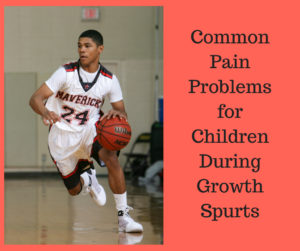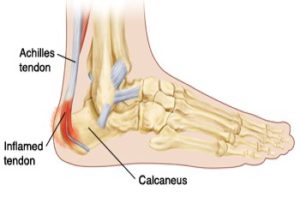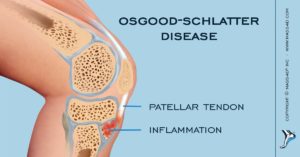
Two common issues experienced by children going through growth spurts are Sever’s Disease and Osgood-Schlatter’s Disease. Both conditions involve painful irritations of the growth plates in developing bones. Read on to learn more about how these issues are recognized and treated.
Sever’s Disease
Sever’s Disease, or calcaneal apophysis, is an inflammation of the growth plate in the heel bone (calcaneus) of growing children. This issue is caused by repetitive stress to the heel or the Achilles tendon which attaches to the heel. Therefore, it is not uncommon in very active children. Sports that put children at higher risk of Sever’s Disease include track, basketball, soccer, and gymnastics due to the high impact nature of these sports. Besides sports, there are other factors that increase risk of developing Sever’s Disease in children regardless of their activity level. These can include the following:
- Pronated foot: pronated or ‘flat feet’ cause increase tension on the Achilles tendon, which pulls on the growth plate of the heel bone.
- Leg length discrepancy: Although uncommon, if one leg is shorter than the other, the asymmetry of the limbs adds excess stress on the Achilles tendon. Sometimes developing kids can have a structural leg length asymmetry, where their bones have growing at an unequal rate, creating an actual measurable difference in the limbs. It is also possible to have an acquired leg length discrepancy, which would mean that one leg is “acting’ longer than the other because of a misalignment of the pelvis, back, or hip. This sort of situation can occur during sports if the child sustains a fall onto 1 hip, or lands hard on 1 leg when coming down from in the air.
- Pelvic dysfunction: More common than a true leg length discrepancy, there can also be an ‘off-kilter’ pelvic alignment from muscle imbalances which would cause an excess ‘pull’ on the Achilles tendon. As mentioned above, this can happen during the bumps and tumbles that occur during sport activity. A pelvic asymmetry can also develop due to awkward sitting postures or sleep positions
- Overweight or obese status: excess body weight results in increased pressure and stress on the growth plate and bones of developing children. It is also harder for the Achilles tendons to push increased body mass during walking, running, and stairs, which can trigger pain.
Signs and symptoms of Sever’s Disease
- Swelling and/or redness in the heel
- Pain in the heel or Achilles regions and/or difficulty with walking or running
- Tenderness when the heel is squeezed on both sides
- Stiffness in the morning or after lengthy periods of sitting

Osgood-Schlatter Disease
Osgood-Schlatter Disease (OSD) is an inflammation of the bone, cartilage, and/or tendon at the top of the tibia (shin bone) called the tibial tuberosity where the quadriceps tendon attaches. OSD is one of the most common causes of knee pain in adolescents and is most common in active adolescents going through growth spurts. The reason that children going through growth spurts are more likely to get OSD is because their bones are growing more quickly than their muscles and tendons. This causes the quadriceps tendon to ‘pull’ on the tibial tuberosity causing increased bone growth of the tibal tuberosity.
The risk factors described above for Sever’s Disease are also related to Osgood-Schlatter. Any time that leg alignment is altered, the compensations of the hip, knee, and ankle joints can build up to create pain disorders. In growing kids, pain occurs more quickly because of their developing bone and tendon structures. However, adults are also susceptible to pain issues due to poor limb alignment.
Signs and symptoms of Osgood-Schlatter Disease
- Knee pain below the knee cap on the anterior (front) part of the knee
- Pain that increases with exercises such as running or jumping
- Swelling, tenderness, and increased bone growth (a visible lump) at the tibial tuberosity
- Tight quadriceps muscles

For more information about these pain disorders, check out these links to KidsHealth for Sever’s Disease and for Osgood-Schlatter’s.
So, what can be done for a kid with heel or knee pain?
In the case of both Sever’s Disease and Osgood-Schlatter Disease, the pain experienced during activity often stems from strength and/or flexibility imbalances that develop as the result of growth spurts in kids and adolescents. This typically means that these painful conditions are relatively temporary and are likely to improve as the child’s body stabilizes and adapts. However, simple rest and avoidance of painful activity does not constitute a comprehensive treatment strategy. Targeted management of the pain and of any structural imbalances contributing to the problem can help. Strategies that assist with awareness and treatment of individual risk factors and modifications to activity, footwear, warm-up routines, etc. can allow kids with these diseases to better participate in their favorite activities.
It is appropriate to seek out a physical therapist’s assessment and opinion when your child is having these types of pain problems. Physical therapy treatment will typically consist of functional stretching and strengthening of the affected muscles, along with core strengthening and movement and/or balance training. A physical therapist can also apply hands-on manual therapy techniques to address things like leg length asymmetry or stiff or poorly positioned joints – all of which can relieve pain and improve activity tolerance. A physical therapist can also assist patients and their families with appropriate activity modification and set-up an effective home-based exercise program to keep symptoms at bay. As with any pain problem, individual consideration and a personally designed and adapted treatment program during the course of the disease process are likely to generate better results than non-specific “boiler plate” handouts with generalized recommendations.
If you have questions about these common kid pain problems, please contact us at Symmetry. We are very familiar with treating adolescent orthopedic disorders like Sever’s and Osgood-Schlatter’s and would be happy to help your child to get back to peak performance!
